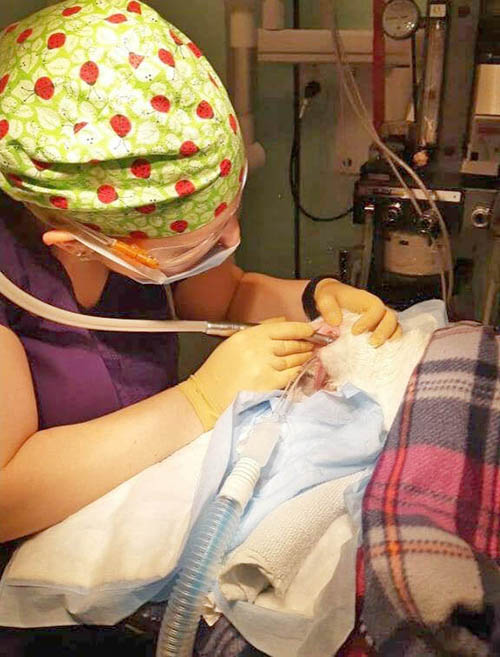Most pet parents know the benefits of good dental hygiene for their cats and dogs. You drop your animal off in the morning with one of our technicians and pick them up later in the day with sparkling white teeth and a pain-free mouth. But what happens in between? Today we’re following Mary, a 15-year-old cat in need of some dental care.
Like all our anesthetic patients, Mary was fasted overnight and dropped off by her owner where she was checked in. At this time, one of our registered veterinary technicians (RVTs) goes over any concerns that you might have about the procedure. See how your pet is doing and go over the estimate of costs with you. They are here to put your mind at ease, so if you have questions, they’re happy to answer them.
If your pet hasn’t had bloodwork recently, then our RVTs will obtain a blood sample prior to anesthesia. It lets us measure your pet’s red and white blood cell counts, blood glucose, blood protein levels, liver and kidney function so that we know your pet is safe to be under general anesthetic. If we find abnormalities, we’ll contact you to discuss our plan going forward. Some abnormalities may stop us from doing the dental procedure, while some mean that we have to modify our protocol a little. Mary had an Early Detect Package (full bloodwork, plus thyroid level and urinalysis) a week prior to her dental, so didn’t have blood taken the morning of her procedure. Mary has some declining kidney function, but with some modifications like increasing her IV fluid rate, she is still a good candidate for anesthesia.
Once we have blood results, it’s time for sedation! A little sedative is given to help us place an IV catheter more easily, and reduce pain and anxiety in our patients. The addition of the sedation means that we can use fewer anesthetic drugs, which helps keep temperature, blood pressure and heart rate more stable while the patient is asleep.
When the catheter is in place, an injection is given to allow them to relax and fall asleep completely. A tube is placed in the trachea so we can safely manage their airway while they’re asleep. It lets us control the amount of anesthetic gas and oxygen they receive, as well as helps prevent fluids in the mouth during the dental from ending up in the airway. Under the direction of the attending veterinarian, an RVT monitors your pet anesthetic during the dental procedure; this includes measuring temperature, heart rate, blood oxygen levels, blood pressure, carbon dioxide levels, EKG and breathing rate. All patients have IV fluid therapy, warm water circulating bed, and lots of blankets. Dentals can be long procedures, and we strive to keep our patients as comfortable as possible.
As soon as the patient is stable, we move on to charting! While one RVT is monitoring the anesthetic, the second RVT acts as a dental hygienist. Charting is an important step that records any damaged or missing teeth, the level of tartar and gingivitis present and any other abnormalities that might be present.
After charting, comes scaling. We use the same equipment as your dentist and dental hygienist, with both ultrasonic and hand scalers to remove tartar build-up from teeth. (Our techs love this part!).
Next step is dental radiographs (“x-rays”). Many times, dental disease doesn’t just show on the visible part of the tooth (the crown) but may be lurking under the gum line as well. Dental radiographs allow us to evaluate better the whole mouth, including the parts we can’t see. Digital technology gives us better image quality, plus endless storage, so if an animal needs a dental again in the future, we can compare past and present images.
When the radiographs are finished, then the veterinarian steps in! We’ve been in the background up to this point, but like the dentist comes in after the hygienist sees you, our talented RVTs do the base work for all our dental procedures. After reviewing the radiographs and assessing the mouth and discussing with our RVT, we decide what (if anything) needs to be extracted. We promise that we only extract what we have to; we always have your pet’s best interests at heart. Once we know what we need to extract, dental nerve blocks (“freezing”) is injected to help keep the patient comfy. In Mary’s case, she ended up with one tooth removed on one side and three on the other, mostly due to feline oral resorptive lesions (cat “cavities”).
After extractions, the RVT steps back in to handle the polishing and rinse the now pearly white, clean teeth. After this, we gently reposition the patient and repeat the same procedure on the other side. An injection of an anti-inflammatory is given to help cut down on post-operative pain, so your pet is comfortable when they wake up. When we’re finished, the patient moves to a recovery area with a warm, soft bed where they stay on fluids to help flush the anesthetic out of their body and help to wake up. We’ll give you a call at this point and let you know how they made out, and what we did, as well as when you can come to pick them up. One of our RVTs will discharge your pet back to you when they’re ready to go home and will go over any medications that are needed, follow up care that might be needed and answer any other questions you might have.
Whew, that’s a lot! Dentals can be very involved in procedures, but good dental care is paramount to your pet’s health and well being. At Fairview Animal Hospital, we pride ourselves on our dental care, and we’re more than happy to set up an appointment to discuss your pet’s oral health needs.












If you have any questions, give us a call at 902-443-9385.
Written by: Dr. Charlotte Ramey